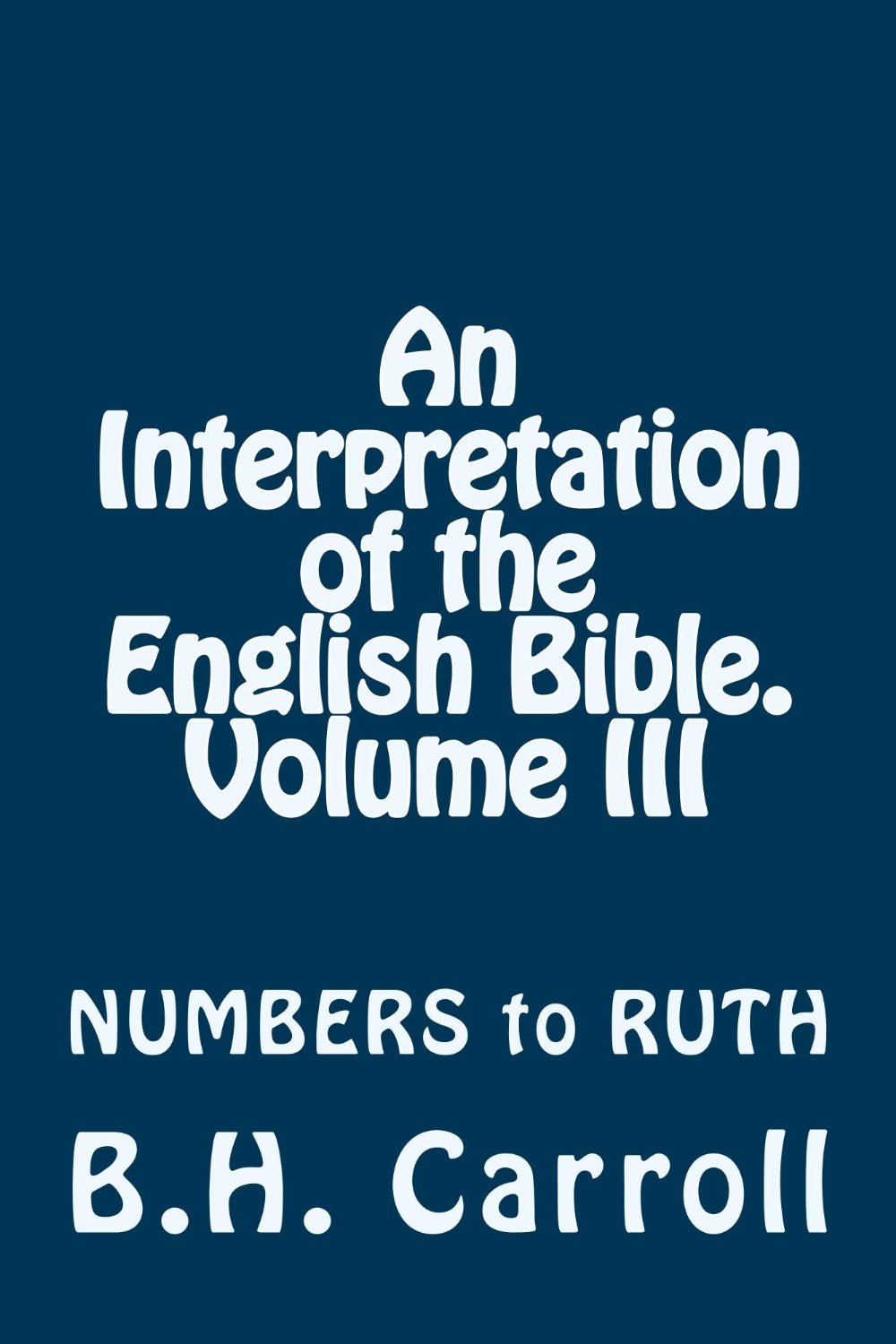Description
An Interpretation of the English Bible Volume III
NUMBERS to RUTH
by
B. H. CARROLL
Table of Contents
Contents
THE BOOK OF NUMBERS. 5
I CHRONOLOGICAL ANALYSIS. 5
II INTRODUCTION. 15
III FROM SETTING UP OF THE TABERNACLE TO THE FIRST MARCH 22
IV FROM SINAI TO KADESH-BARNEA. 29
V EVENTS AT KADESH-BARNEA. 36
VI AFTERMATH OF THE BREACH OF THE COVENANT AT KADESH-BARNEA 44
VII FROM KADESH-BARNEA TO MOAB. 51
VIII BALAAM: HIS IMPORTANT PROPHECIES, HIS CHARACTER, AND HIS BIBLE HISTORY 58
IX ISRAEL’S SIN AND PHINEHAS’ ACT OF RIGHTEOUSNESS, AND OTHER THINGS 66
THE BOOK OF DEUTERONOMY. 75
X GENERAL INTRODUCTION. 75
XI THE ANALYSIS: SOME OBJECTIONS ANSWERED.. 84
XII FIRST AND SECOND ORATION, PART I 95
XIII SECOND GREAT ORATION, PART 2. 106
XIV THIRD, FOURTH, AND FIFTH ORATIONS. 117
XV THE SONG, PRAYER, AND BENEDICTION OF MOSES 126
XVI THE CHARACTER AND GREATNESS OF MOSES. 136
XVII THE HOMILETIC VALUE OF DEUTERONOMY. 148
THE BOOK OF JOSHUA. 156
XVIII HISTORICAL INTRODUCTION. 156
XIX JEHOVAH’S CHARGE TO JOSHUA. 169
XX THE MIRACULOUS PASSAGE OF THE JORDAN AND EVENTS AT GILGAL 181
XXI THE FALL OF JERICHO, AI, EBAL, AND GERIZIM.. 191
XXII CONQUEST OF THE NORTHERN TRIBES; ALLOTMENT OF TERRITORY; ESTABLISHMENT OF A CENTRAL PLACE OF WORSHIP. 203
XXIII BRIEF REVIEW; RETURN OF WARRIORS OF THE TWO AND A HALF TRIBES 213
THE BOOK OF JUDGES. 223
XXIV INTRODUCTION. 223
XXV INTRODUCTION (Continued) AND OUTLINE FURTHER REMARKS ON THE INTRODUCTION. 232
XXVI EVENTS PRECEDING THE JUDGES AND SOME SPECIAL DELIVERERS 241
XXVII DEBORAH AND BARAK, DEBORAH’S SONG.. 252
XXVIII DEBORAH’S SONG (Concluded); MIDIAN AND GIDEON 263
XXIX THE STORY OF ABIMELECH, THE USURPER, AND OF JEPHTHAH 273
XXX SAMSON. 282
XXI MICAH AND THE DANITES, OUTRAGE OF THE MEN OF GIBEAH, AND THE NATIONAL WAR AGAINST BENJAMIN. 294
A BOOK OF RUTH.. 305
XXXII A CATECHISM.. 305
THE BOOK OF NUMBERS
I CHRONOLOGICAL ANALYSIS
I. The itinerary from Egypt to Sinai, Numbers 33:1-15, connecting with Exodus 12:37 to 19:2.
II. All the events and legislation in chapters 7-9, connect in order of time with Exodus 40 as follows: second year, first month, first day, the book of Exodus closes with setting up the tabernacle which Moses could not enter until dedicated.
The Next Twelve Days.
1. The offerings of the princes, Numbers 7:1-86.
2. The dedication, Numbers 7:87-88.
3. Moses now enters and hears the voice, Numbers 7:89.
4. Purification of the tribe of Levi for service, Numbers 8:1-26.
Fourteenth Day.
1. Observance of the Second Passover, Numbers 9:1-5.
2. Occasion of the Provision for the Little Passover, Numbers 9:6-14.
III. The Legislation in Numbers 5-6 connects in order of time with Leviticus and these two chapters of Numbers with Leviticus cover all the rest of the first month – say
Sixteen Days.
1. Lepers put out of the camp, Numbers 5:1-4.
2. Restitution in case of trespass, Numbers 5:5-10.
3. The trial of Jealousy, Numbers 5:11-31.
4. The law of the Nazarite, Numbers 6:1-21.
5. Form of the high priest’s benediction, Numbers 6:22-27.
IV. First Nineteen Days Second Month, devoted to preparation for first march to Promised Land, Numbers 1-4; 9: 15-23; 10:1-10,14-32.
1. Terminal dates of this section, Numbers 1:1, and 10:11.
2. Numbering the warriors of the twelve secular tribes, 603,550, Numbers 1:1-46.
3. Order of their encampment, Numbers 2.
4. The tribe of Levi exempted from secular and war service and tribal inheritance and appointed to a religious service because about to be exchanged for the firstborn of the secular tribes – the firstborn being Jehovah’s, chapters 1:47-54, and 3:1-13.
5. Census of male Levites from one month old and upward as basis for proposed exchange, number 22,000, 3:14-16, 39.
6. Census of firstborn males of the twelve secular tribes as the other basis for proposed exchange – number 22,273, 3:40-43.
7. Redemption price of the secular excess, 273, 3:44-51.
8. Special charge of all Levites, by families, in marching and camping and their order of encampment, 3:17-38.
9. Second census of male Levites for the hard service of marching and camping – this time from thirty years to fifty – number 8,580 – and the distribution of duties by families, chapter 4.
10. Signals of marching and camping:
(1) The pillar of cloud, 9:15-23.
(2) The trumpets, 10:1-10.
(3) The ark, 10:33.
(4) The words of Moses, 10:35-36.
11. Regular order of marching and camping, 10:14-28.
12. The invitation to Hobab – his service and the promised blessing, 10:29-32. (Note the great pulpit theme, 10:29.)
V. Forty-eight Days. From Sinai to Kadesh-barnea, Numbers 10:11-33, and chapters 11-12; 23:16-18.
1. Distance – 150 miles at least.
2. Time of starting – 10:11, Time in day marches (Deuteronomy l:2)=== eleven days. Time in resting at Kibroth (II: 20) = thirty days. Time in resting at Hazeroth (12:14-15) =seven days. Time total forty-eight days at least, probably more.
3. Character of the way, Deuteronomy 1:19; 8:15; 32:10.
4. The Itinerary, Numbers 33:16-18.
5. Events by the way: At Taberah, 11:1-3.
(1) This is a mere night encampment at close of first or second day’s march.
(2) The sin of murmuring against God, its punishment by fire and the intercession of Moses. At Kibroth, 11:4-34.
(3) The place – in the edge of the wilderness of Paran – three days’ journey from Sinai – about thirty miles from Sinai, 10:12,33.
(4) Time, thirty days 11:20.
(5) The sin of loathing God’s provision and lusting for the food of bondage, 11:4-6.
(6) Description of the manna and how prepared for food, 11:7-9.
(7) Displeasure of Moses and his appeal to Jehovah, 11:10-15.
(8) Jehovah in reply to the appeal of Moses provides and qualifies seventy executive officers to assist Moses in administration, as he had previously appointed and qualfied seventy Judges to assist him in judicial matters, II: 16-17,24-25.
(9) The strange case of Eldad and Medad, and its lesson that neglect of some technical forms does not invalidate God’s appointment nor restrain his Spirit, 11:26. Compare 2 Chronicles 33:18-20.
(10) Joshua’s mistaken jealousy and the larger spirit of Moses, 11:27-29. Compare Mark 9:38-40, and Acts 11:17. (Note the great pulpit theme 11:29, but who is able to preach just right on 11:26-28; 2 Chronicles 33: 18-20; Mark 9:38-40; Acts 11:17?)
(11) Jehovah grants and punishes the wicked lusts of the people, 11:18-20, 31-34.
(Note that their sin was rejection of Jehovah, 11:20.)
(Note the origin of the saying, “No man can eat a quail a day for thirty days consecutively.”)
At Hazeroth, 11:35 to 12:15.
(12) No note in the text of how many days’ march from Kibroth – perhaps four.
(13) The great sin of Miriam and Aaron against Moses and God and its punishment and healing on the intercession of Moses.
(14) Time at least seven days. (Note the author’s explanation of Moses’ Cushite wife.) The March from Hazeroth to Kadesh, 12:16. Time, perhaps four days. No event recorded.
VI. Events and Legislation at Kadesh-barnea, chapters 13-19. Time indefinite, Deuteronomy l:46= forty-two days specified.
The place – in northern edge of the Wilderness of Paran (12:16), called also Rithmah, Numbers 33:18, on the southern border of the Promised Land, 34:4, in the hill country of the Amorites, Deuteronomy 1:20, west of the Arabah. (See Kadesh-Barnea, by H. Clay Trumbull, for exact location and description.)
1. The case of. the spies.
(1) Who suggested sending the spies, Deuteronomy 1:22? It would have shown greater faith to obey God’s command immediately and trust to him, Deuteronomy 1:21. Both God and Moses let them have their way, Numbers 13:1.
(2) The spies examine all the Promised Land and find it as Jehovah had reported it, but in their report ten of them speak evil of the land and magnify the power of the enemies holding it, and minimize the power of Israel and openly distrust God, 13:4-33. (Note the great pulpit theme of unbelief and cowardice in verse 33.)
2. The second great breach of the covenant, God’s threat of destruction, the intercession of Moses, the mixed pardon and penalty, 14:1-35.
3. The fate of the ten cowards and the good destiny of the two faithful ones, 14:36-38.
4. The people’s great sin of presumption and its result, 14: 39-45.
5. Prospective legislation which inspires hope of yet reaching the Promised Land, chapter 15.
6. The sin and punishment of Korah and his company and the memorial thereof, 16:1-40.
7. Continued rebellion of the people, its punishment and atonement by Aaron, 16:41-50.
8. The rod of Aaron and its preservation as a token, and the despair of the cast-off people, chapter 17.
9. Special charge of the Levites and provision for their support, chapter 18.
10. The red heifer, or the water of purification, chapter 19. (Compare this typical element of regeneration with Psalm 51:2; Ezekiel 36:25; Zechariah 13:1; John 3:5; Ephesians, 5:26; Titus 3:5; Hebrews 9:13, and note that regeneration always consists of two parts: First, cleansing by the Spirit’s application of Christ’s blood; and, second, renewing of the heart and mind. See author’s sermon on the “Human Side of Regeneration” in his first volume of sermons.)
VII. The long silent period of the wanderings, about thirty-seven years.
1. The itinerary, Numbers 33:19-36.
2. The covenant being broken, circumcision, its token, not observed, Joshua 5:2-9.
3. That generation being outcasts, Jehovah commanded no sacrifices (Jeremiah 7:22) and they offered none but served idols (Amos 5:25, and Acts 7:42-43).
4. Yet for the sake of the coming generations, Jehovah cared for them, Deuteronomy 2:7; 29:5-6; Nehemiah 9:19-21.
VIII. Events at Kadesh-barnea once more. Several months, commencing with the first month in the fortieth year, 20:1; 33:38.
1. The reassembling at Kadesh, 20:1.
2. Death of Miriam in the place where she had sinned thirty-seven years before, 20:1.
3. A second rebellion at Kadesh, 20:2-6.
4. The sin of Moses and Aaron in smiting the rock and its chastisement announced, 20:7-13. (Compare this passage with 20:24; 27:14; Deuteronomy 1:37; 3:26-27; Psalm 106:32-33, and analyze the sin of Moses.)
5. The attack on Israel by the Canaanites and their subsequent doom, 21:1-3.
6. Passage through Edom refused, 20:14-21.
IX. Over thirty days from Kadesh to Mount Hor in the border of Edom. The death of Aaron and the appointment of Eleazar as high priest, 20:22-29; 23:37, 39.
X. Time five months exactly. (Compare 33:38; 20:29; Deuteronomy 1:3.) From Mount Hor, around Edom, to the banks of the Jordan opposite Jericho – the events by the way – the events and legislation there:
1. The itinerary, 33:41-49. (Compare Numbers 21:10-35; Deuteronomy 2:1-37.)
2. The Brazen Serpent 21:4-9.
3. Quotations from a lost book, 21:14.
4. The well and the song, 21:16-18.
5. The fall of Sihon and another song, 21:21-32.
6. The fall of Bashan, 21:33-35.
7. The case of Balaam and his prophecies, chapters 22-24. Compare Jude 2; 2 Peter 2:15; Revelation 2:14. (After reading sermons on Balaam by Bishop Butler, Dr. Arnold, Cardinal Newman, Spurgeon, and the author, noting the several lines of thought, make your own analysis showing the degree and sources of light, his spiritual state, his great sin and character – then state the messianic element in his prophecies.
8. (1) Balaam, failing to turn Jehovah against Israel by divination, turns Israel against Jehovah by a terrible sin, 25:1-3, 6-15.
(2) Hanging the chiefs does not atone, 25:4.
(3) Slaying the guilty does not atone, 25:5.
(4) The sin culminates in an awful act of presumption, 25:6.
(5) Atonement by Phinehas, 25:7-15. (Expound those most remarkable passages in the Old Testament, Numbers 25:11-13; Psalm 106:30-31, and particularly make clear this second case of “imputed righteousness” and develop the atonement idea in the zeal of Phinehas and find its antitype in Christ’s atonement.)
9. The second census, chapter 26.
10. Provision of inheritance for daughters without father or brother, 21:1-11.
11. Joshua set apart as successor to Moses, 27:12-23.
12. The offerings day by day, sabbath by sabbath, moon by moon, year by year, feast by feast, chapters 28-29. (These chapters could be made into a calendar for the Jewish Holy Year.)
13. Exceptions to the law of Vows previously given, 33.
14. Holy War against Midian led by Phinehas, who had atoned for the sin of Israel, 31. (Particularly note the character of this war, as the execution of a divine sentence, led by a priest with only 12,000 men who suffer no loss, and the devoted character of the spoils.)
15. The plea of Reuben and Gad for inheritance east of the Jordan and the conditions under which it will be granted, 32.
16 The itinerary from Egypt to Jordan, whose several parts have already been noted, 33.
17 The borders of the land, 34:1-12. (Compare the borders here given with Genesis 15:18-21; Deuteronomy 1:7-8, and other passages.)
18 Half-tribe of Manasseh to receive inheritance with Reuben and Gad, and the appointment of twelve princes who, with Joshua and Eleazar, shall divide the land, 34:16-29.
19. Directions for forty-eight Levitical cities, six cities of refuge and laws defining privileges of refuge, 35.
20. Law for securing to the tribe inheritance already provided for daughters without father or brother.







Reviews
There are no reviews yet.